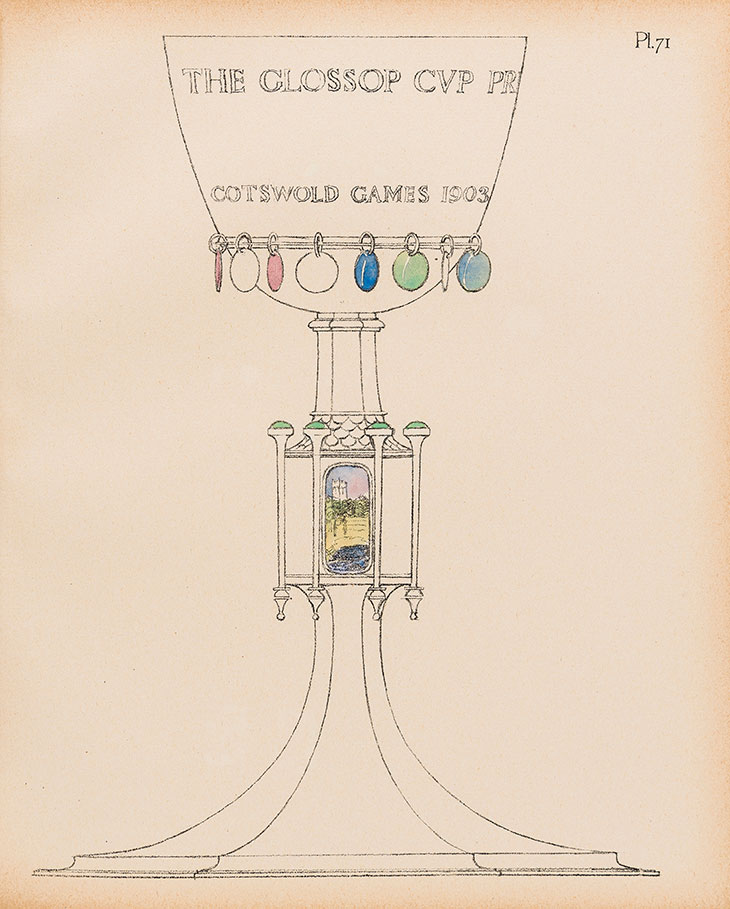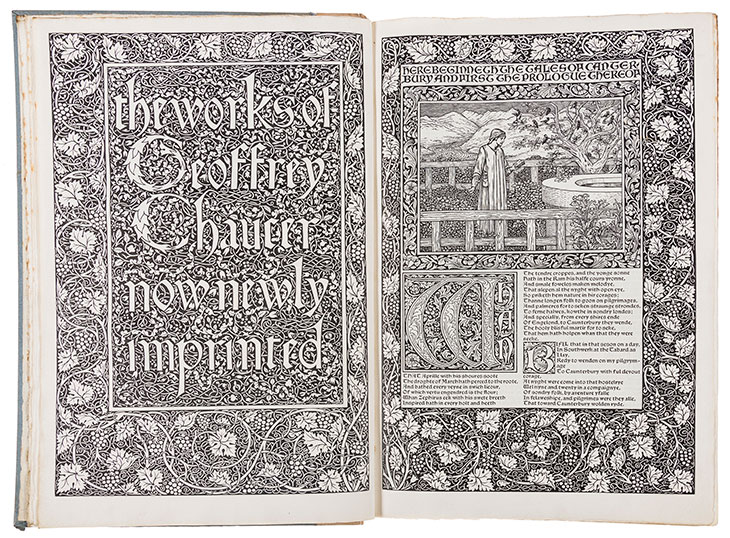An important auction of books selected from the Birmingham Assay Office Library will, at the time of writing, take place at Forum Auctions in London on 26 March (the sale will be conducted online – or ‘behind closed doors’). The volumes, in more than 450 lots, were collected by the Office over roughly 200 years, following its foundation in 1773. When acquired, they were thought relevant to its purposes and those of its customers, mainly fine metalworkers from the city.
Included is Balthazar George Sage’s L’Art d’Essayer l’Or et l’Argent… (Paris, 1780), which was a predictable acquisition for an assay office, required as it was to test and mark precious metals, as was literature on silversmithing, such as C.R. Ashbee’s Modern English Silverwork (Broad Campden, 1909), one of only 200 copies signed by the author, which contains roughly 150 of his designs.
Plate from C.R. Ashbee’s Modern English Silverwork (Broad Campden, 1909). Courtesy Forum Auctions

Library purchases reflected the wide range of metalworking activities carried out in Birmingham. These include horology, with Thomas Mudge’s Thoughts on the Means of Improving Watches… (London, 1765), estimated at £2000–£3000, and coining – as in a copy of the first and only edition of Rice Vaughan’s A Discourse of Coin and Coinage, the first historical monograph in English on money, produced in London in 1675, with an estimated price of £600–£800.
Much is of a technical nature. There is a first edition of the earliest book on metallurgy, Vannoccio Biringuccio’s De la Pirotechnia, which was produced in Venice in 1540 (estimate: £10,000–£15,000). For jewellers, there is Thomas Nicols’ A Lapidary: Or, The History of Precious Stones (Cambridge, 1652), the first book in English on the subject. Several books are on mining – including William Borlase’s The Natural History of Cornwall (Oxford, 1758), covering minerals and metals – and many books are on chemistry: a copy of Hermann Boerhaave’s influential A New Method of Chemistry is an example of the first English edition, translated by P. Shaw and E. Chambers in 1727 (estimate: £1,000–£1,500).
Plate from Le Mobilier Funéraire Gallo-Roman et Franc en Picardie et en Artois (Paris, 1902). Courtesy Forum Auctions

Prior to the advent of modernism, archaeological volumes were widely used as sources by designers. Boulanger’s Le Mobilier Funéraire Gallo-Roman et Franc en Picardie et en Artois (Paris, 1902) is exquisitely presented with chromolithographed illustrations, many heightened with gold and/or silver. Victorian designers, at the centre of the imperial enterprise, had a hunger to know more about distant lands: William Simpson and John William Kaye’s India Ancient and Modern is another chromolithographed publication, published in London in 1867. It is priced at £15,000–£20,000.
Works by important artists often served as inspiration for designers. Lot 161, expected to sell for up to £40,000 (one of the highest valuations in the sale), includes original drawings by many important artists including 44 original drawings by John Flaxman, many for silver. Edward Burne-Jones’s tightly packed woodcut illustrations crowd William Morris’s edition of The Works of Geoffrey Chaucer (1896) for the Kelmscott Press.
The Kelmscott Chaucer. Courtesy Forum Auctions

The Birmingham Assay Office has served as a hub for local studies. Carrying the same estimate of £300–£400, and similar in date, are Stebbing Shaw’s The History and Antiquities of Staffordshire (1798–1801) and Joseph Priestley’s An Appeal to the Public on the Subject of the Riots in Birmingham (1791–92) – riots from which the author greatly suffered.
A splendid Bible (lot 68), once belonging to Matthew Boulton and published in 1763 by John Baskerville, both prominent 18th-century Birmingham men, has been the focus of local disappointment about the strong possibility of the loss of so many volumes from the city. However, local efforts, with the support of the Assay Office, are being made to retain the Bible for the city; and it is worth noting that it has been withdrawn only a few days before the sale.
The Birmingham Assay Office’s decision to sell historical volumes (while retaining its own records and more recent books directly related to its needs) is based, it argues, on the lack of a suitable environment and funding to look after antique books, following the move to new premises in 2014, and reflects too the limited usage of those books in recent years by makers and scholars. The proceeds of the sale will be used for investment in the Office’s legal duty to assay precious metals, and other services such as the certification and valuation of other materials, and tracing makers’ and sponsors’ marks – and help to safeguard the future of the Assay Office.
The Birmingham Assay Office Library Sale takes place ‘behind closed doors’ at Forum Auctions, London, on 26 March. More information is available here.



